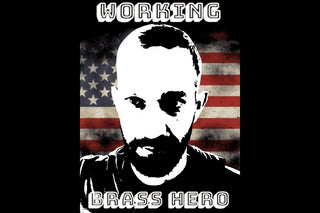I recently compiled some thoughts on achieving effective practice sessions. These concepts are universally applicable for all instrumentalists, not just horn players like myself!

Planning. Plan regular times for your sessions. Ideally these are 2-3 sessions per day, each with a different focus. For example, the first session of the day might be focused purely on warmup and fundamentals, while later sessions might be more geared toward music-making and creativity. In my personal experience, 3 sessions of practice throughout the course of a day seems to be almost magical. Sessions can each range from 20 minutes to one hour in length, and may be adjusted based on the demands of the day–but this takes just a bit of foresight and organization.

Goals. Create clear goals for each session. Be sure not to overreach! Setting effective goals is about determining what you can achieve reasonably, without attempting to bite off more than you can chew. You may set a tempo goal for a passage or an etude, then bump it up daily. Or maybe you just aim to get one particular phrase or excerpt to sound more musical or accessible to the listener. Examples of overreaching might include the following: attempting to learn a full concerto in one session, or trying to change your embouchure in one day. These endeavors will undeniably end in frustration, and can actually yield regressive results.

Creativity. Do you love being a musician? If so, it can be easier to stay curious and inspired about the pursuit of mastering your craft. The best musicians in the world have spent countless hours in solitude doing fine detail and big-picture work. But how did they do that without getting bored? Surely there were days of boredom, fatigue and burnout, but on the whole, they were able to maintain a childlike curiosity about their craft. Environment and inspiration can play a big role in this. When you surround yourself with people whose art inspires and challenges you, evolution is a certainty. Sometimes you must proactively seek out this inspiration, but that’s easier than ever in the highly connected world of today. At age 83, the cello virtuoso, Pablo Casals was asked why he continued to practice four and five hours a day. Casals answered, “Because I think I am making progress.”

Recording and Playback. Have you ever thought that you performed something really well, only to be disappointed with the playback? Yup, we’ve all been there. The truth hurts, but the truth is also the best teacher. In our modern world, there is no excuse to forego recording yourself as a part of your practice routine. Quality of equipment is not terribly important–any smart phone or handheld device will do. When you begin the process in earnest, try not to be discouraged. See the playback for what it is: information. I find it helpful to regularly record mock auditions and run-throughs of solos or etudes, mainly because having a red blinking light raises the stakes, giving way to a more realistic performance mindset and increased accountability.

Strengths & Weaknesses. We all have different qualities to offer as musicians, which is part of what makes individual artistry so unique and special. It’s important to be honest with ourselves about our own strengths and weaknesses, and apply that knowledge to our practice. Most of us love to practice those elements that come easily and make us sound great. There is room for this type of practice, as it can inspire confidence and joy, both of which are critically important to the development process. However, true honesty comes with acknowledging weaknesses and deficiencies, and actively seeking to address those aspects on a regular basis. Finding the balance between practicing strengths and weaknesses is a key to success.

Quiet your mind. Unfocused or distracted practicing can waste the most valuable commodity that we have: time. Being mindful and present is crucial in performances, but also in practice sessions. Give yourself permission to think of your practice time as a refuge from the outside world. If you cultivate this feeling, your practice sessions can feel almost indulgent–and that’s okay! We must learn to find delight and solace in the journey.

Don’t force it. We’ve probably all experienced the feeling of a forced practice session. This occurs when you push beyond healthy limits, either physically, mentally, or both. At best, forced practice ingrains bad habits, and at worst, it can cause injury or burnout. Bottom line: forced practice is not the type of practice that we want to cultivate. Some strategies to avoid forced practice include planning well in advance and allowing for longer term preparation for a given performance or project (ie: no cramming!), and instituting good mental practice strategies that allow for more physical rest within and between sessions.

Mental practice. Quality mental practice can be just as beneficial and effective as physical practice. When correctly executed, mental practice can solidify technique, allow for physical rest and recovery, and enhance your phrasing and musical expression. Good mental practice may take the form of visualization with an emphasis on technical execution, sublime musical virtuosity, or both. It’s important to remember that there are no limits or boundaries on the stage that you create in your own mind.

Find your space. Although we may not all have ideal practice studios, it’s important to attempt to find a consistent physical space in which to practice. A small, dead practice room can be sobering, but it is also refreshingly honest. When possible, find (or create) a physical space that allows you to be your most productive self. I recognize that this can be a challenge. Sometimes not having access to a familiar space can take us out of our groove, which can feel unsettling. Do your best to welcome these moments by embracing the change. In these situations, you might tailor your session to a strange and different acoustic, or change your routine to incorporate new challenges directly.

Practice performing. Be sure to designate a portion of your practice time to performance. This could take the form of mock auditions, run-throughs with a recording device, or impromptu mini concerts for friends and family members (in-person or virtual). Ask your peers to listen to you and return the favor. Play for folks who play your instrument. Play for folks who don’t play your instrument. Play for folks who have never played an instrument. We should strive to chip away at the barrier between the practice room and the performance hall, so that we’re not surprised or unprepared when we finally take our product from behind closed doors and into the public eye.
I hope you found this entry helpful. If so, please share and feel free to leave a comment below!
Mark Houghton authors the Working Brass Hero Blog. He has played French horn professionally for twenty years. Mr. Houghton has been a member of the world-renowned, Grammy-award-winning Pittsburgh Symphony Orchestra since 2014. Additionally, he is a founding member and part owner of Houghton Horns, and Adjunct Professor of Horn at Duquesne University. Mark lives in the South Hills of Pittsburgh with his loving and supportive wife, Katie, and their three amazing children: Camille, Charlotte, and Maxwell. Mark is not a writer, but he’s trying real hard. He is constantly taking on new projects, despite the fact that he has no time for them. Mark will never turn down espresso before 4pm on most days, and has a penchant for tequila and grass-fed steak. He is obsessed with the game of soccer.

